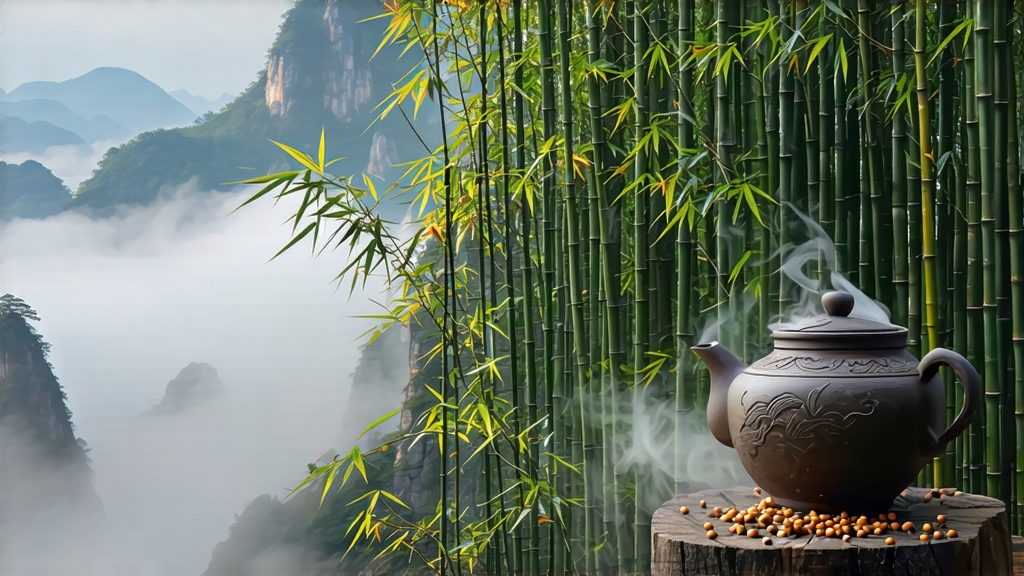
Tucked high in the mist-veiled Dabie Mountains of western Anhui Province, Huoshan Huangya has quietly captivated Chinese emperors, Tang-dynasty poets and modern tea aesthetes for more than fourteen centuries. Unlike the assertive smoke of Lapsang or the floral bomb of Tie Guan Yin, this yellow tea speaks in whispers: a mellow, chestnut-sweet liquor that lingers like late-afternoon sunlight on old pine boards. To understand why the Qing court once levied it as tribute, and why today it commands prices rivalling top-grade Longjing, one must follow the leaf from Tang-era stone inscriptions to the bamboo-lined roasting rooms where “menhuang” micro-fermentation turns green into gold.
Historical vignettes first surface during the Tang dynasty (618-907) when Lu Yu, the sage of tea, recorded “Huozhou yellow slices” in his Classic of Tea. Those compressed cakes, steamed and baked, were not yet the loose, tender bud tea we know, but the terroir was already celebrated. By the Ming, local chronicles describe “buds picked at Qingming, wrapped in silk, carried by horse to Nanjing within three days.” The name Huangya—literally “yellow bud”—appears formally in 1630, and by the Qianlong reign (1736-1795) the imperial Household Department listed it among only eight teas permitted at the palace’s Spring Festival banquet. After the fall of the Qing, production lapsed; the craft survived in a single mountain hamlet, Dongxiyu, where elders still recite the mantra “three roastings, three suffocations, seven days of waiting.” State-sponsored revival in 1972 restored acreage, yet only 180 mu (12 hectares) of the original heritage gardens remain, clinging to granite cliffs between 600 and 800 m elevation.
Botanically, Huoshan Huangya belongs to the small-leaf landrace Camellia sinensis var. sinensis ‘Huoshan Qunti’, a slow-budding population that develops soluble sugars during cold spring nights. Standard of identity restricts plucking to one bud or one bud with one just-unfurled leaf, before the Qingming festival when average diurnal temperature swing exceeds 15 °C. Such rigid timing yields a mere 350 g of finished tea per tea bush each year, explaining why authentic Huangya is rarely exported beyond boutique quantities.
The craft sequence, recognized as provincial intangible heritage since 2008, is best observed in the village of Foziling where pine-fired longkang (heated benches) still dominate. After a brief outdoor withering of two hours, the buds are pan-fired at 140 °C for four minutes—just enough to deactivate leaf enzymes while preserving the pale-green hue. The critical “menhuang” (sealed yellowing) follows: hot leaves are piled in bamboo trays, covered with wet linen, and left in a 30 °C, 85 % humidity room for 40–60 hours. During this micro-fermentation chlorophyll degrades into pheophytin, catechins oxidize partially, and a yellow pigment—unique to yellow teas—forms, lending the dried leaf its distinctive primrose color and the cup its luminous topaz glow. Finally, three low-temperature roastings (80 °C, 70 °C, 60 °C) over charcoal drawn from local chestnut wood reduce moisture to 5 % while imprinting a whisper of toasted buckwheat. The entire cycle spans seven labor-intensive days, compared with one day for most green teas.
Western aficionados often confuse yellow tea with lightly oxidized oolong, yet chemical profiling reveals a different fingerprint: Huangya’s theaflavin level hovers at 0.8 % (similar to green tea) but its theabrownin reaches 2.3 %, triple that of green teas, yielding a rounder body without the floral aldehydes typical of oolong. A 2021 study by the Anhui Academy of Agricultural Sciences also identified a rare amino acid, theanine-methyl-ester, present only in menhuang-processed leaves, believed to account for the tea’s lingering sweet finish and calming effect.
To unlock these subtleties, water is more important than timing. Use spring water at 85 °C—never boiling—and a tall, thin-walled glass or a 120 ml gaiwan. For the first infusion, 3 g of leaf (about a level tablespoon)